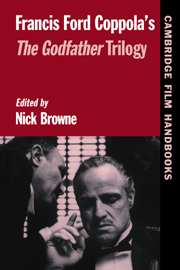Book contents
- Frontmatter
- Contents
- Acknowledgments
- List of Contributors
- Francis Ford Coppola's Godfather Trilogy
- Fearful A-Symmetries
- 1 If History Has Taught Us Anything … Francis Coppola, Paramount Studios, and The Godfather Parts I, II, and III
- 2 The Godfather and the Mythology of Mafia
- 3 The Representation of Ethnicity in The Godfather
- 4 Ideology and Genre in the Godfather Films
- 5 Family Ceremonies: or, Opera in The Godfather Trilogy
- Filmography
- Reviews of the “Godfather” Trilogy
- Select Bibliography
- Index
5 - Family Ceremonies: or, Opera in The Godfather Trilogy
Published online by Cambridge University Press: 05 June 2012
- Frontmatter
- Contents
- Acknowledgments
- List of Contributors
- Francis Ford Coppola's Godfather Trilogy
- Fearful A-Symmetries
- 1 If History Has Taught Us Anything … Francis Coppola, Paramount Studios, and The Godfather Parts I, II, and III
- 2 The Godfather and the Mythology of Mafia
- 3 The Representation of Ethnicity in The Godfather
- 4 Ideology and Genre in the Godfather Films
- 5 Family Ceremonies: or, Opera in The Godfather Trilogy
- Filmography
- Reviews of the “Godfather” Trilogy
- Select Bibliography
- Index
Summary
If the concluding sequences of Godfather III bring the epic saga of the Corleone family to a tragic end, they also represent the most dramatic culmination of what is, certainly, one of the underlying impulses of the Godfather films: that is, their operatic cast. As if to underscore the role played by opera throughout the films, Mary Corleone is shot to death on the steps of the Teatro Massimo Opera House in Palermo after a long sequence set within the opera house itself. In the course of this sequence, Mary and her parents, Michael and Kay Corleone, witness a performance of Pietro Mascagni's 1890 operatic work, Cavalleria Rusticana, in which the Corleone son, Anthony, sings a leading role. Intercut with actions taking place within and without the opera house, scenes of Mascagni's opera provide mise en abime for critical moments of the film even as they go to the core of Coppola's esthetic.
Important as they may be, scenes of actual opera houses or performances constitute, as I hope to show, but one aspect – albeit the most explicit – of the love for opera that gives Coppola's work a special resonance. The influence, in particular, of two Italian composers of the previous century – that is, of Mascagni himself and of Verdi – is felt not only in this sequence but throughout the trilogy. Clearly influenced by romantic and verist Italian opera of the past century, Coppola may also owe a debt to two of the most “operatic” of Italian film makers: that is, Luchino Visconti and Bernardo Bertolucci.
- Type
- Chapter
- Information
- Francis Ford Coppola's The Godfather Trilogy , pp. 133 - 156Publisher: Cambridge University PressPrint publication year: 1999
- 1
- Cited by



